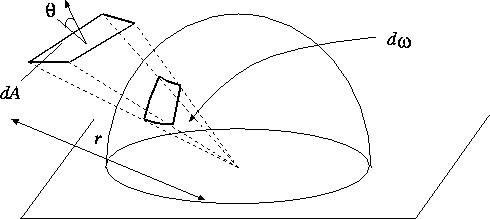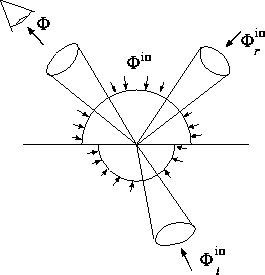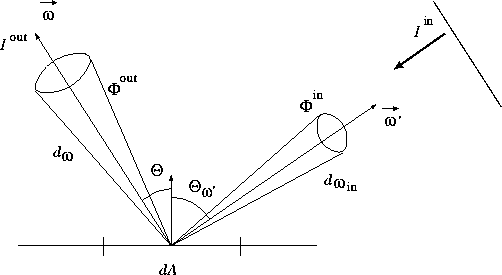The main goal of computer graphics is to calculate the image that could be seen by a camera in a virtual world. This requires the calculation of the power reaching the camera from a given direction, i.e. through a given pixel, taking into account the optical properties of the surfaces and the lightsources in the virtual world.
The spectral properties of this power are responsible for the color sensation. In computer graphics the power is usually evaluated on a few (at least 3) representative wavelengths, then the colour sensation is determined from these samples.
Hereinafter, monochromatic light of a representative wavelength ![]() will
be assumed, since the complete color calculation can be broken down to these
representative wavelengths. The parameters of the equations usually depend on
the wavelength, but for notational simplicity, we do not always include the
will
be assumed, since the complete color calculation can be broken down to these
representative wavelengths. The parameters of the equations usually depend on
the wavelength, but for notational simplicity, we do not always include the
![]() variable in them.
variable in them.
In the next section, we briefly review the measures of the light transport and the mathematical formulation that can compute them.

The directional property of the energy emission is described in a so-called
illumination hemisphere which contains those solid angles to where the
surface point can emit energy. By definition, a solid angle is a cone
or a pyramid, with its size determined by its subtended area of a unit sphere
centered around the apex (figure  ).
The solid angle, in which a differential dA surface can be seen from point
).
The solid angle, in which a differential dA surface can be seen from point
![]() , is obviously the projected area per the square of
the distance of the surface. If the angle between the surface normal of dA
and the directional vector from dA to
, is obviously the projected area per the square of
the distance of the surface. If the angle between the surface normal of dA
and the directional vector from dA to ![]() is
is ![]() , and the distance
from dA to
, and the distance
from dA to ![]() is r, then this solid angle is:
is r, then this solid angle is:
![]()
The intensity of the energy transfer is characterized by several metrics in computer graphics depending on whether or not the directional and positional properties are taken into account.
The light power or flux ![]() is the energy radiated through a
boundary per unit time over a given range of the spectrum
(say
is the energy radiated through a
boundary per unit time over a given range of the spectrum
(say ![]() ).
).
The radiance, or intensity I, is the
differential
light flux leaving a surface element dA in a differential solid angle
![]() per the projected area of the surface element and the size of the
solid angle. If the angle of the surface normal and the direction of interest
is
per the projected area of the surface element and the size of the
solid angle. If the angle of the surface normal and the direction of interest
is ![]() , then the projected area is
, then the projected area is ![]() , hence the
intensity is:
, hence the
intensity is:

Having introduced the most important metrics, we turn to their determination in
the simplest case, where there are only two differential surface elements in
the 3D space, one (dA) emits light energy and the other (dA') absorbs it
(figure  ).
If dA' is visible from dA in solid angle
).
If dA' is visible from dA in solid angle ![]() and the radiant
intensity of the surface element dA is
and the radiant
intensity of the surface element dA is ![]() in this direction,
then the flux leaving dA and reaching dA' is:
in this direction,
then the flux leaving dA and reaching dA' is:
![]()
according to the definition of the radiant intensity. Expressing the solid angle by the projected area of dA', we get:
This formula is called the fundamental law of photometry.
Note that the transferred power can also be written in the following form:
![]()
Thus similar formula applies for the patch that receives the power as for the patch that emits it.
In light-surface interaction the surface illuminated by an incident beam may reflect a portion of the incoming energy in various directions or it may absorb the rest. It has to be emphasized that a physically correct model must maintain energy equilibrium, that is, the reflected and the transmitted (or absorbed) energy must be equal to the incident energy.
Optically perfect or smooth surfaces will reflect or transmit only coherent components governed by the laws of geometric optics, including the law of reflection and the Snellius-Descartes law of refraction. The incoherent components are caused by the surface irregularities reflecting or refracting the incident light in any direction. Since the exact nature of these irregularities is not known, the incoherent component is modeled by means of probability theory.
Assume that a photon comes from the direction denoted by
![]() to point
to point ![]() .
The probability of reflection or refraction at
.
The probability of reflection or refraction at ![]() onto the
solid angle
onto the
solid angle ![]() around
around ![]() is expressed by the following
density function:
is expressed by the following
density function:
![]()
Note that this probability distribution is a mixed, discrete-continuous distribution, since the probability that the light may obey the laws of geometric optics is non-zero. The energy equilibrium guarantees that the integration of the probability density over the whole sphere is 1.

The light flux ( ![]() ) leaving the surface at the solid angle
) leaving the surface at the solid angle ![]() around
around ![]() consists of the indirect and direct (emission) components.
consists of the indirect and direct (emission) components.
The indirect component is expressed as the integration of the
contribution of all the possible incoming directions ![]() over the sphere around the surface:
over the sphere around the surface:
![]()
If the surface itself emits energy, that is, if it is a lightsource, then the direct component (emission) also contributes to the output flux:
![]()
Adding the possible contributions we get:

The fluxes can be expressed by the radiant intensities, thus:
![]()
![]()
Substituting these terms into equation 9 and dividing both
sides by ![]() we get:
we get:
![]()
Let us realize that ![]() is equal to
is equal to
![]() if
if ![]() is the point that is
visible from
is the point that is
visible from ![]() at direction
at direction ![]() , usually expressed
by the so called visibility function h (
, usually expressed
by the so called visibility function h ( ![]() ).
).
Using these equations and introducing
![]() that is called the bi-directional
reflection/refraction function or BRDF for short, we get the
following fundamental formula, called the shading, rendering or
illumination equation:
that is called the bi-directional
reflection/refraction function or BRDF for short, we get the
following fundamental formula, called the shading, rendering or
illumination equation:
Formulae of this type are called rendering equations. In fact, every color
calculation problem consists of several rendering equations, one for each
representative frequency. Surface parameters
( ![]() ) obviously vary in
the different equations.
) obviously vary in
the different equations.
Rendering algorithms are expected to find the solution ![]() of this rendering
equation at least for those points
of this rendering
equation at least for those points ![]() and directions
and directions ![]() which are visible from the eye at direction
which are visible from the eye at direction ![]() . Note
that the unknown intensity (also called radiance) is present
both inside and outside of the integral of the equation. These
types of integral equations are called Fredholm integral
equations of second kind.
. Note
that the unknown intensity (also called radiance) is present
both inside and outside of the integral of the equation. These
types of integral equations are called Fredholm integral
equations of second kind.
In order to simplify the notations, the integral operator of
rendering equation is denoted by ![]() :
:
![]()
Thus the short form of the rendering equation is:
There are two family of techniques that can be used to solve such an integral equation: finite element methods and random walk methods.